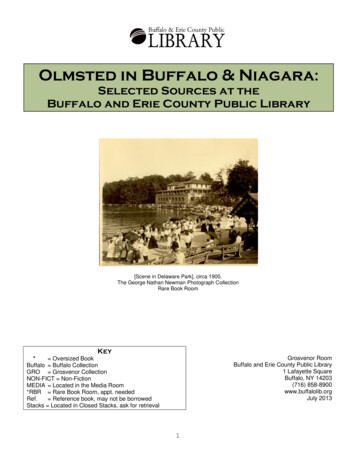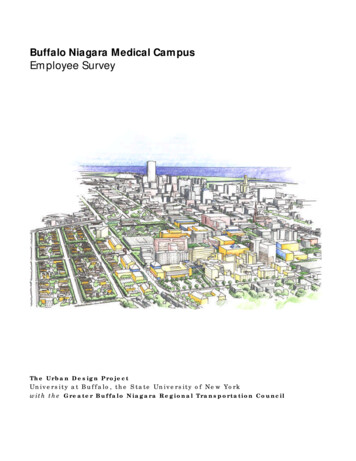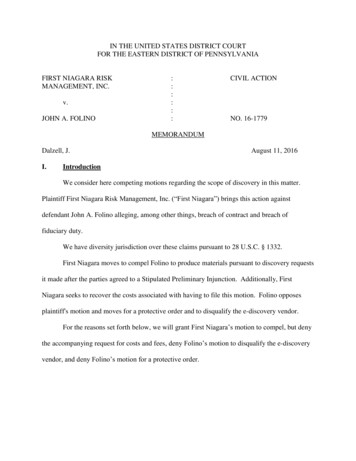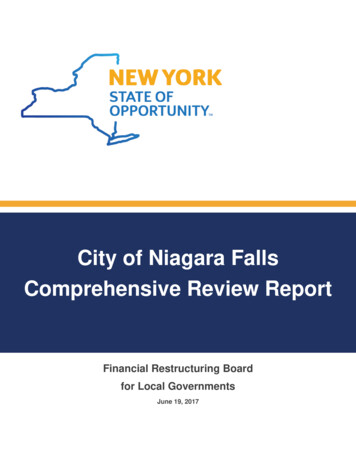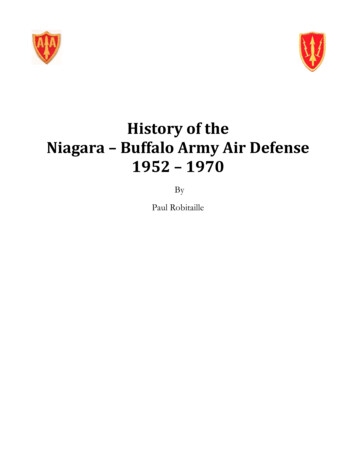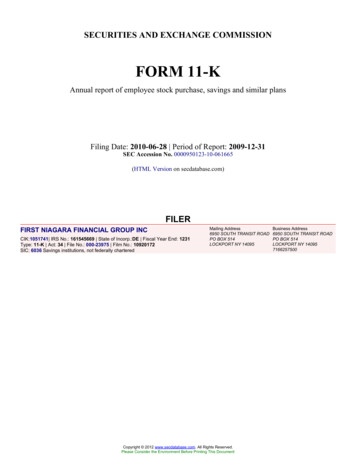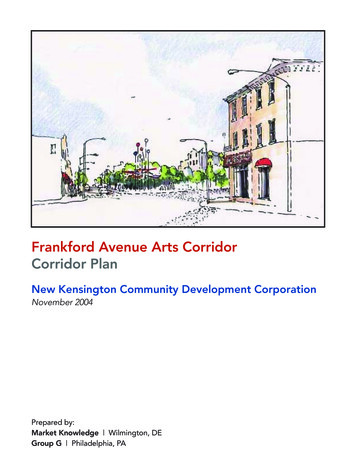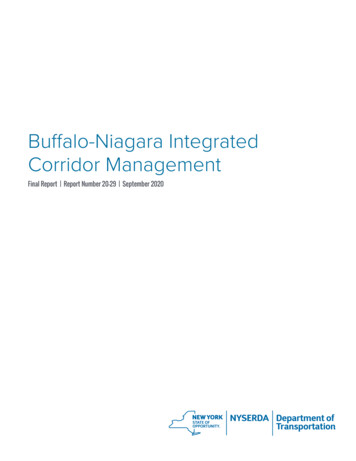
Transcription
Buffalo-Niagara IntegratedCorridor ManagementFinal Report Report Number 20-29 September 2020NYSERDA Department ofTransportation
Buffalo-Niagara Integrated Corridor ManagementFinal ReportPrepared for:New York State Energy Research and Development AuthorityAlbany, NYRobyn MarquisProject ManagerNew York State Department of TransportationAlbany, NYPrepared by:Cambridge SystematicsNew York, NYKeir OpieProject ManagerandTranspo GroupNew City, NYStefanie HerzsteinProject ManagerNYSERDA Report 20-29NYSERDA Contract 46817NYSDOT C-14-57September 2020
NoticeThis report was prepared by Cambridge Systematics and Transpo Group in the course of performingwork contracted for and sponsored by the New York State Energy Research and Development Authority(NYSERDA) and New York State Department of Transportation (NYSDOT) (hereafter the "Sponsors").The opinions expressed in this report do not necessarily reflect those of the Sponsors or the State of NewYork, and reference to any specific product, service, process, or method does not constitute an implied orexpressed recommendation or endorsement of it. Further, the Sponsors, the State of New York, and thecontractor make no warranties or representations, expressed or implied, as to the fitness for particularpurpose or merchantability of any product, apparatus, or service, or the usefulness, completeness, oraccuracy of any processes, methods, or other information contained, described, disclosed, or referredto in this report. The Sponsors, the State of New York, and the contractor make no representation thatthe use of any product, apparatus, process, method, or other information will not infringe privatelyowned rights and will assume no liability for any loss, injury, or damage resulting from, or occurringin connection with, the use of information contained, described, disclosed, or referred to in this report.NYSERDA makes every effort to provide accurate information about copyright owners and relatedmatters in the reports we publish. Contractors are responsible for determining and satisfying copyright orother use restrictions regarding the content of the reports that they write, in compliance with NYSERDA’spolicies and federal law. If you are the copyright owner and believe a NYSERDA report has not properlyattributed your work to you or has used it without permission, please email print@nyserda.ny.govInformation contained in this document, such as web page addresses, are current at the timeof publication.Preferred CitationNew York State Energy Research and Development Authority (NYSERDA). 2020. “Buffalo-NiagaraIntegrated Corridor Management.” NYSERDA Report Number 20-29. Prepared by CambridgeSystematics (New York, NY) and Transpo Group (New City, NY). nyserda.ny.gov/publicationsi
DOT Table1. Report No. C-14-572. Government Accession No.3. Recipient's Catalog No.4. Title and Subtitle5. Report DateBuffalo-Niagara Integrated Corridor ManagementSeptember 20206. Performing Organization Code7. Author(s)8. Performing Organization ReportNo.Cambridge Systematics and Transpo Group20-299. Performing Organization Name and Address10. Work Unit No.Greater Buffalo-Niagara Regional Transportation Council (GBNRTC)438 Main Street, Suite 503Buffalo, New York 1420211. Contract or Grant No.Niagara International Transportation Technology Coalition93 Oak StreetBuffalo, NY 1420313. Type of Report and PeriodCovered12. Sponsoring Agency Name and AddressNYS Department of Transportation50 Wolf RoadAlbany, New York 12232Final Report14. Sponsoring Agency Code15. Supplementary NotesProject funded in part with funds from the Federal Highway Administration.16. AbstractThis report documents the Buffalo-Niagara Integrated Corridor Management (BNICM) deployment planning study for portions of the region’s freewaynetwork. Integrated Corridor Management (ICM) provides technology-enabled transportation management and operations strategies that seek tooptimize the use of existing infrastructure. Following a presentation of the overall concept of operations for the BNICM deployment, the reportpresents a detailed analysis of the impacts of two ICM alternatives, one freeway-focused only, and one also including arterial traffic signaloptimization, with cost-benefit analysis determining that the latter is optimal. Travel-time savings was found to be the single largest category ofbenefits from the BNICM deployment, with benefits greater during day-to-day morning and afternoon rush hour periods than during less-usualscenarios (crashes, professional sports events, etc.). Of the ICM strategies considered, the highest-impact strategy was found to be DynamicTraveler Information, Freeway Incident Detection and Service Patrol. This report concludes with a plan of next steps for implementing the BNICM’sstrategies and monitoring, once operational.17. Key Words18. Distribution StatementIntegrated Corridor Management, Intelligent TransportationSystemsNo Restrictions19. Security Classif. (of this report)Unclassified20. Security Classif. (of this page)UnclassifiedForm DOT F 1700.7 (8-72)ii21. No. of Pages 22. Price372
AbstractThis report documents the Buffalo-Niagara Integrated Corridor Management (BNICM) deploymentplanning study for portions of the region’s freeway network. Integrated Corridor Management (ICM)provides technology-enabled transportation management and operation strategies that seek to optimizethe use of existing infrastructure. Following a presentation of the overall concept of operations for theBNICM deployment, the report presents a detailed analysis of the impacts of two ICM alternatives,one freeway-focused only, and one also including arterial traffic signal optimization, with cost-benefitanalysis determining that the latter is optimal. Travel-time savings was found to be the single largestcategory of benefits from the BNICM deployment, with benefits greater during day-to-day morningand afternoon rush hour periods than during less-usual scenarios (crashes, professional sports events,etc.). Of the ICM strategies considered, the highest-impact strategy was found to be Dynamic TravelerInformation, Freeway Incident Detection and Service Patrol. This report concludes with a plan of nextsteps for implementing the BNICM’s strategies and monitoring, once operational.KeywordsIntegrated Corridor Management, Intelligent Transportation SystemsTable of ContentsNotice . iPreferred Citation . iDOT Table . iiAbstract .iiiKeywords.iiiList of Figures .viList of Tables .viAcronyms and Abbreviations .viiExecutive Summary .ES-11Introduction . 11.1Purpose . 11.2Stakeholders . 31.3Study Area. 4iii
2341.4Transportation Context . 61.5Project Activities and Approach . 7Project Management Plan .102.1Scope . 102.2Intended Audience . 102.3Update Process . 10System Engineering Management Plan.113.1Intended Audience . 113.2Relationship to PMP . 113.3Update Process . 11Concept of Operations and Requirements.124.1Goals and Objectives . 124.2System Components . 124.2.1Freeway Incident Detection and Service Patrol . 134.2.1.1 BNICM Implementation . 144.2.1.2 Estimated Costs . 144.2.2Ramp Metering . 154.2.2.1 BNICM Implementation . 174.2.2.2 Estimated Costs . 194.2.3Variable Speed Limits and Queue Warning . 194.2.3.1 BNICM Implementation . 214.2.3.2 Estimated Costs . 234.2.4Variable Toll Pricing . 244.2.4.1 BNICM Implementation . 244.2.4.2 Estimated Costs . 274.2.5Signal Coordination . 284.2.5.1 BNICM Implementation . 294.2.5.2 Estimated Costs . 324.2.6Other Strategies Considered . 334.2.6.1 Parking ITS . 334.2.6.2 Dynamic Lane Controls . 354.2.6.3 Road Weather Information Systems and Plow Management . 354.3System Evaluation . 364.3.1Strategy Packages for Base Conditions . 38iv
5Analysis, Modeling, and Simulation .405.1Model Development . 405.2Evaluation Scenarios . 405.3Performance Metrics . 415.4Results . 425.4.1Vehicle Hours Traveled . 425.4.2Vehicle Miles Traveled . 465.4.3Emissions . 485.4.4Benefit-Cost . 495.4.4.1 Package A . 505.4.4.2 Package B . 535.56Implementation Plan .576.1Deployment and Implementation Next Steps . 576.2I-190 Corridor Implementation Plan . 596.3Border Crossing Implementation Plan . 606.4Performance Monitoring and Reporting Plan . 616.4.1Detailed Field Monitoring . 626.4.2Simulation Monitoring . 636.4.3Performance Reporting Summary . 656.57Lessons Learned . 56Future ICM Projects Considerations . 656.5.1Study Design and Data Needs . 666.5.2ICM Strategies . 676.5.3Analysis, Modeling, and Simulation. 68Bibliography .69Appendix A: Project Management Plan . A-1Appendix B: System Engineering Management Plan . B-1Appendix C: Concept of Operations and Requirements . C-1Appendix D: ICM Strategies Primer . D-1Appendix E: Performance Measures . E-1Appendix F: Analysis, Modeling, and Simulation . F-1v
List of FiguresFigure 1. Buffalo-Niagara ICM Project Region. 5Figure 2. Project “Vee” Diagram . 8Figure 3. Example of VSL Zone and Speed Detection Point. .22Figure 4. Variable Toll Impacts for Southbound Weekday AM Peak-Period Traffic .25Figure 5. Variable Toll Impacts for Northbound Weekday PM Peak-Period Traffic .26Figure 6. Corridors Considered for Signal Coordination .30Figure 7. Game Day Parking Facilities .34List of TablesTable 1. ICM Goals . 2Table 2. NITTEC Agencies . 3Table 3. Cost Estimates for Freeway Incident Detection and Service Patrol .15Table 4. Proposed Ramp Meter Activations by Time Period.18Table 5. Cost Estimates for Ramp Metering Deployment .19Table 6. Cost Estimates for Variable Speed Limits and Queue Warnings .23Table 7. Cost Estimates for Signal Coordination .33Table 8. ICM Strategies by Base Condition .39Table 9. Daily VHT Benefits from ICM Deployment Package A .43Table 10. Daily VHT Benefits from ICM Deployment Package B .45Table 11. Daily VMT Benefits from ICM Deployment Package A .46Table 12. Daily VMT Benefits from ICM Deployment Package B .47Table 13. Daily Emission Benefits (Metric Tons CO 2 ) from ICM Deployment Package A .48Table 14. Daily Emission Benefits (Metric Tons CO 2 ) from ICM Deployment Package B .49Table 15. Annual VHT Benefits from ICM Deployment Package A .51Table 16. Annual VMT Benefits from ICM Deployment Package A .51Table 17. Annual Emission Benefits (Metric Tons CO 2 ) from ICM Deployment Package A .52Table 18. Benefit Cost Ratio for ICM Deployment Package A .53Table 19. Annual VHT Benefits from ICM Deployment Package B .54Table 20. Annual VMT Benefits from ICM Deployment Package B .54Table 21. Annual Emission Benefits (Metric Tons CO 2 ) from ICM Deployment Package B .55Table 22. Benefit Cost Ratio for ICM Deployment Package B .55vi
Acronyms and AbbreviationsAMSAnalysis, Modeling, and SimulationATSPMAutomated Traffic Signal Performance MeasuresAVLBODAutomated Vehicle Locationboard of directorsCBSACanada Border Services AgencyCO 2carbon dioxideConOpsconcept of operationsCBPCustoms and Border ProtectionDMSdynamic message signsFHWAFederal Highway AdministrationGPSGBNRTCGlobal Positioning SystemGreater Buffalo-Niagara Regional Transportation CouncilHCMHighway Capacity ManualHELPHighway Emergency Local PatrolICMIPDTIntegrated Corridor ManagementIntegrated Product Development TeamITSIntelligent Transportation SystemsINCOSEInternational Council on Systems EngineeringIMDSSInterstateMaintenance Decision Support SystemsMPOMetropolitan Planning OrganizationMTONPMRDSMinistry of Transportation, OntarioNational Performance Management Research Data SetNYSNew York StateNYSDOTNew York State Department of TransportationNYSERDANew York State Energy Research and Development AuthorityNYSPNew York State PoliceNYSTANew York State Thruway AuthorityNFBCNiagara Falls Bridge CommissionNFTANITTECNiagara Frontier Transportation AuthorityNiagara International Transportation Technology CoalitionOCCOntario Chamber of CommerceOPPOntario Provincial PoliceO&MPMBOKoperations and maintenanceProject Management Body of KnowledgePMPproject management planRWISRoad Weather Information Systemvii
SEBoKSystems Engineering Body of KnowledgeSEMPSystem Engineering Management PlanSEPsystems engineering processesTMCtraffic management centerTSMOTransportation Systems Management and OperationsTOPS-BCTools for Operations Benefit Cost AnalysisUSCBPUnited States Customs and Border ProtectionU.S. DOTUnited States Department of TransportationVHTvehicle hours traveledVMTvehicle miles traveledVSLvariable speed limitviii
Executive SummaryThis report documents the Buffalo-Niagara Integrated Corridor Management (BNICM) deploymentplanning study, which aimed at advancing the ICM concepts toward deployment in both the Buffaloand Niagara regions. This project strives to take the current traffic management procedures to the nextlevel by leveraging and building upon the available resources, tools and ICM goals and objectives.The overall BNICM planning study included a five-year process that developed a project managementplan (PMP), System Engineering Management Plan (SEMP), concept of operations (ConOps) andrequirements, Analysis Modelling and Simulation (AMS) and then an implementation plan formoving forward.The study area of the Niagara Frontier is the border region that encompasses the Niagara River bordercrossings and is a strategic international gateway for the flow of trade and tourism between the UnitedStates and Canada. I-190 between the I-90 and I-290 interchanges is the primary focus area within theBuffalo-Niagara region for this study. The study area also includes the Peace Bridge border crossing.The specific ICM strategies that were selected for consideration and inclusion in ICM response plansfor the BNICM AMS include the following: Improved Dynamic Traveler InformationFreeway Incident Detection and Service PatrolRamp MeteringVariable Speed Limits and Queue WarningsVariable Toll PricingSignal Coordination (along Niagara Street)The ICM strategies were evaluated for a typical weekday commute during AM and PM peak-periodconditions, vehicle crash conditions, holiday demands, snow conditions, and game day conditions.Since the permutations of various ICM strategies and base conditions to be evaluated in the BNICMmodel presented an immense number of scenarios to simulate and analyze, two packages (A and B)of ICM strategy deployments were developed to streamline the simulation and evaluation of theeffectiveness of the ICM strategies during the different base conditions. Package A focused onfreeway ICM strategy deployment while package B included freeway deployment as well assignal coordination along the arterial system.ES-1
The resulting benefit cost of the ICM strategies showed 2.77 for package A and 3.37 forpackage B. Based on the AMS performed for the BNICM on packages A and B, the key findingsinclude the following: VHT showed the greatest benefit relative to deployment of the ICM strategies.Typical weekday AM and PM peak-period conditions improved or benefited the most withthe ICM deployment, whereas other conditions had improvement but to a lesser degree.Traveler information and freeway incident clearance were the two strategies that providedthe most improvements in the system related to the ICM strategies deployed.Emissions positively benefited from deployment of ICM but only by a small amountwhen monetized.Arterial signal management resulted in a large increase in the benefit-cost ratio.This study shows that based on the benefit cost of the ICM strategies efforts to design and deploythe systems on the region’s roadways are economically justifiable.The next step toward an ICM deployment in the region would consist of a more detailed design anda more robust analysis of the costs to deploy, operate, and maintain the ICM system components inthat region. Consideration should be given to staged or phased ICM deployment to spread the initialdeployment costs. Specific to the cross-border corridor, next steps toward implementation shouldinclude a more detailed examination of the possibility of trucks changing their crossing locationson short notice to improve travel times from an incident on either side of the border.While the study simulation and benefit-cost analysis demonstrates the feasibility and viability of anICM deployment in the region, any potential deployment should also include a data driven processto continually monitor the performance of the ICM system and its response plans that are implementedin the field. The results of that performance monitoring should also carry forward into a continuousimprovement framework to ensure that the ICM response plans implemented in the field are as beneficialas they can be for the given conditions as an ICM system operates over time. Performance monitoringwould be conducted using both field data and the simulation model. The use of the BNICM simulationtool can also be leveraged for this performance reporting in a future ICM system. This performancereporting provides the data needed to enhance and improve the simulation model over time, whichshould in turn lead to more accurate predictions of the impacts of an ICM response plan under varyingconditions and improved response plan performance in the real world.ES-2
1IntroductionThis report documents the Buffalo-Niagara Integrated Corridor Management (BNICM) deploymentplanning study. The study was completed for the New York State Energy Research and DevelopmentAuthority (NYSERDA), Greater Buffalo-Niagara Regional Transportation Council (GBNRTC), NiagaraFrontier Transportation Authority (NFTA), Niagara International Transportation Technology Coalition(NITTEC), and the United States Department of Transportation’s (U.S. DOT) Federal HighwayAdministration (FHWA).Integrated Corridor Management (ICM) provides transportation management and operationsstrategies, enabled by Intelligent Transportation Systems (ITS), that seek to optimize the use ofexisting infrastructure in a selected corridor network, while enhancing safety and reducing thenegative externalities associated to congestion.Compared to the traditional approach to corridor management, ICM provides more active managementof a corridor’s operations, through three mechanisms: 1.1Motorists are provided better information to empower them to make better-informed decisions.Motorists may be charged tolls at variable rates, to incentivize choosing to travel duringless-congested time periods and to better match network capacity with traffic demands.Network capacity is actively managed by rapid removal of capacity-reducing incidents,better traffic signal optimization, etc.PurposeThe purpose of the BNICM planning study is to develop a combined stakeholder vision of efficienttransportation operations on the Interstate (I) 190 corridor. The ICM is intended to provide improved(1) integration of operational procedures, (2) facilitation of emergency response, and (3) disseminationof traveler information in the I-190 corridor and in the larger border crossing corridor in theNiagara Frontier.The outcome of the study is an implementation plan. The implementation plan is based on the Analysis,Modeling, and Simulation (AMS) of potential ICM deployments in the region. The AMS is used todetermine the feasibility of an ICM deployment and assess benefits to operational and environmentalconditions on the region's transportation network. The goals for the BNICM that guided the study aresummarized in Table 1.1
Table 1. ICM GoalsSource: NITTEC Transportation Operations Integrated Corridor Management Requirement Document, February 2010.Goal CategoryGoal ObjectiveAgency CoordinationImprove center-to-center communicationsTraveler InformationImprove accuracy of congestion (travel time) information reliabilityEnable intermodal choices through improved traveler informationImprove integration of weather information/data for traveler information,and for maintenance operationsImprove integrated operations based on real-time dataMobility (Arterial, Border,Freeway, Transit)Maximize the free flow of traffic and reduce congestionProvide transit alternative and park-and-ride facilitiesEnhance border crossing clearanceFacilitate ITS and operational improvements that will facilitate ICM mobilityEnhance alternative route management capabilitiesIncident ManagementEstablish incident classifications and severity guidelinesImprove and coordinate incident managementThe following are overall objectives of this BNICM study: Develop decision support tools needed to complete the required AMS assessmentsof the potential IC
Greater Buffalo-Niagara Regional Transportation Council (GBNRTC) 438 Main Street, Suite 503 Buffalo, New York 14202 . Niagara International Transportation Technology Coalition 93 Oak Street Buffalo, NY 14203 10. Work Unit No. 11. Contract or Grant No. 12. Sponsoring Agency Name and Address NYS Department of Transportation 50 Wolf Road

